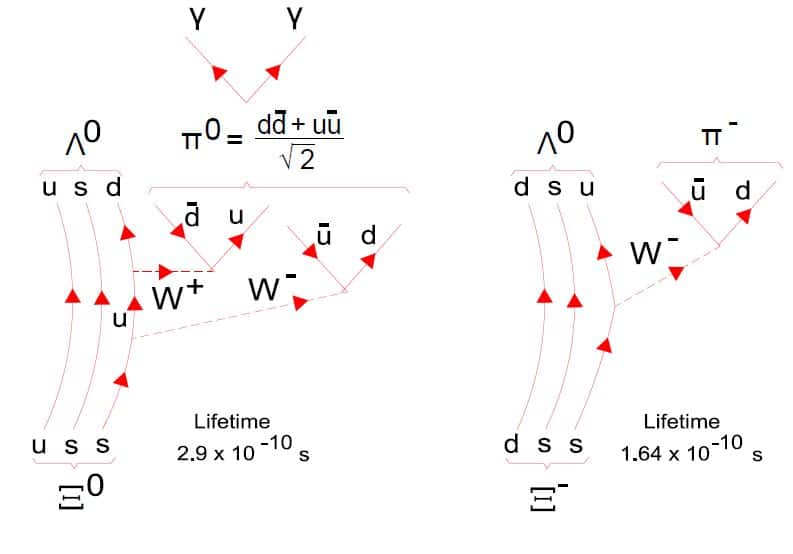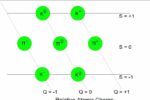Xi Baryon, Types, Properties, and Equation of Decay.
In physics, the Xi baryon (Ξ baryon) is another type of baryon, which is a subatomic particle composed of three quarks. Like other baryons, Xi baryons are hadrons, meaning they are made up of quarks bound together by a strong nuclear force. The name “Xi” is derived from the Greek letter “Ξ” (Xi), used to denote its classification.
What is Xi baryon?
In physics, the Xi baryon (Ξ baryon) is another type of baryon, which is a subatomic particle composed of three quarks. Like other baryons, Xi baryons are hadrons, meaning they are made up of quarks bound together by a strong nuclear force. The name “Xi” is derived from the Greek letter “Ξ” (Xi), used to denote its classification.
The Xi baryons were first discovered in 1964 by the Brookhaven National Laboratory. They have been studied extensively in particle accelerators, and they provide important insights into the strong and weak interactions.

Types of Xi Baryons:
Xi baryons are characterized by the combination of three quarks, typically consisting of one up (u) or one down (d) quark and two strange (s) quarks. There are three common types of Xi baryons:
1. Xi-minus (Ξ–):
Xi-minus (Ξ–) is composed of two strange quarks (s) and one down quark (d) or dss. The strange quark has a charge of -1/3, the down quark has a charge of -1/3, and so the total charge of the Xi-minus is -1.
The Xi-minus is a very unstable particle, and it decays through weak interaction. The most common decay mode is a Lambda baryon and a pion, but it can also decay to a neutron and a kaon. The lifetime of the Xi-minus is about 2.4 x 10^-10 seconds.
2. Xi-zero (Ξ0):
Xi0 (Ξ0) is a neutral baryon, which means it has no net electric charge. It is composed of three quarks: an up quark, two strange quarks or uss. The up quark has a charge of +2/3, while the strange quarks have a charge of -1/3. Therefore, the overall charge of Xi0 is 0.
The symbol for Xi0 is Ξ0, and it is also sometimes called the cascade particle. It has a mass of 1314.96 MeV/c2, and a lifetime of 10.22 × 10-10 seconds. Xi0 can decay into a kaon and a pion, or into a neutron and a lambda baryon.
The Xi-zero is a very unstable particle, and it decays through weak interaction. The most common decay mode is to a Lambda baryon and a pion, but it can also decay to a neutron and a kaon. The lifetime of the Xi-zero is about 2.9 x 10^-10 seconds.
3.Xi-plus (Ξ+):
Xi-plus (Ξ+) is a positively charged baryon, which means it has a net electric charge of +1. It is composed of three quarks: an up quark, two strange quark. The up quark has a charge of +2/3, while the strange quarks have a charge of -1/3. Therefore, the overall charge of Xi-plus is +1.
The symbol for Xi-plus is Ξ+, and it is also sometimes called the cascade particle. It has a mass of 1321.71 MeV/2, and a lifetime of 2.9 × 10-10 seconds. Xi-plus can decay into a kaon and a pion, or into a neutron and a lambda baryon.
Each type of Xi baryon has its own electric charge due to the specific combination of quarks.
Xi baryons are a family of subatomic hadron particles which have the symbol Ξ and may have an electric charge (Q) of +2 e, +1 e, 0, or −1 e, where e is the elementary charge. They are composed of three quarks, and the two more massive quarks can be any two of strange, charm, or bottom (doubles allowed).
Properties of Xi baryons:
Some of the properties of Xi baryons are observed as follows;
- They have a spin of 1/2.
- They have a strangeness of -2.
- They have an isospin of 1/2.
- Their masses range from 1314.86 MeV/c2 to 5.7924 GeV/c2.
- They are unstable and decay through weak interaction.
Xi baryons are an important part of the Standard Model of particle physics. They provide insights into the strong and weak interactions, and they help us to understand the structure of matter.
Decay of Xi Baryons:
Like other baryons, Xi baryons can also undergo various decay processes primarily through weak nuclear force. The specific decay modes and rates depend on the type of Xi particle. When Xi baryons decay, they transform into other hadrons (baryons or mesons) through the exchange of gluons between quarks.
The decay of Xi baryons can be described by the following equations:
- Xi- (Ξ–) decays to a Lambda baryon (Λ0) and a pion (π–):
Ξ– –> Λ0 + π–
- Xi0 (Ξ0) decays to a Lambda baryon (Λ0) and a neutral pion (π0):
Ξ0 –> Λ0 + π0
- Xi- (Ξ–) can also decay to a neutron (n) and a kaon (K–):
Ξ- –> n + K–
The decay of Xi baryons is mediated by the weak interaction. The weak interaction is a short-range force that is responsible for the decay of unstable particles. The weak interaction is also responsible for the process of beta decay, in which a neutron decays into a proton, an electron, and an antineutrino.
The decay of Xi baryons is a relatively rare event. The lifetime of a Xi-baryon is about 2.4 x 10-10 seconds, which means that it will decay on average after traveling about 10-10 meters. The lifetime of a Xi0 baryon is about 2.9 x 10-10 seconds.
The decay of Xi baryons can be used to study the weak interaction. The weak interaction is a very weak force, but it is also very important for understanding the structure of matter. The decay of Xi baryons can provide information about the coupling constants of the weak interaction, which are the strength of the interaction between particles.
decay rate = 1 / lifetime
The decay rate is usually denoted by the Greek letter lambda (λ), and the lifetime is usually denoted by the symbol τ. So, the equation can also be written as:
λ = 1 / τ
Conclusion:
Xi baryons are a group of subatomic particles composed of three quarks. They are classified as “cascade baryons” because they can decay into a lambda baryon and a pion. There are three types of Xi baryons: Xi-zero (Ξ0), Xi-minus (Ξ–), and Xi-plus (Ξ+). Xi baryons are heavy and have short lifetimes, making them ideal for studying the strong nuclear force and the underlying interactions between quarks.
The study of Xi baryons has helped physicists to better understand the fundamental building blocks of matter. As we continue to learn more about Xi baryons, we will gain a deeper understanding of the forces that govern the universe.



0 Comments